Fatehpur Sikri and Ranthambore National Park
Monday and Tuesday, February 12 – 13, 2024
Monday – Fatehpur Sikri and arrival in Ranthambore
Monday was another long travel day, from Agra to
Ranthambore, but the five-hour drive was broken up with a stop at yet another
UNESCO World Heritage site, Fatehpur Sikri, which means “City of Victory.”
Fatehpur Sikri is a walled fortress of red sandstone
built in the 16th century by Mughal Emperor Jalal-ud-din Mohammad
Akbar in honor of the Sufi saint Sheikh Salim Chisti, who supposedly had a
miraculous hand in helping Akbar's wife to produce an heir. According to the UNESCO website, “Fatehpur Sikri was the first planned city of the Mughals to
be marked by magnificent administrative, residential, and religious buildings
comprised of palaces, public buildings, mosques, and living areas for the
court, the army, the servants of the king and an entire city. Upon moving the
capital to Lahore in 1585, Fatehpur Sikri remained as an area for temporary
visits by the Mughal emperors.”
Our guide in Agra, PG, accompanied us on the drive to
Fatehpur Sikri and as we walked through the fortress, he described the
important structures and the history of the site.
Fatehpur Sikri is built on a hilltop still surrounded on
three sides by an eleven-kilometer wall, and the buildings inside truly were
magnificent, with intricate stone carvings, which fused Indian and Islamic art,
decorating many of the walls. These buildings were the palaces of the emperor
and his wives and concubines, as well as administrative buildings such as
Diwan-I-Am (the Hall of Public Audience) and Diwan-Khana-I-Khaas (the Hall of Private
Audience). My favorite building was Hawa Mahal, the Palace of Winds, a five-story structure with
open sides that was designed to catch the wind and cool the emperor and his
family.
 |
| A portion of the huge walls that protect the fortress |
 |
Diwan-I-Am
The Hall of Public Audience |
 |
Diwan-Khana-I-Khaas
The Hall of Private Audience (also known as "the Jewel Box") |
 |
| The interior of Diwan-Khana-I-Khaas |
 |
| Watchtower on the grounds of Fatehpur Sikri |
 |
Ankh Michauli, the Treasury Kiosk is popularly known as the Astrologer's Seat.
It may have been the seat of the Court Treasurer.
The gorgeous Torana arches derives their design from the medieval Jain temples of western India. |
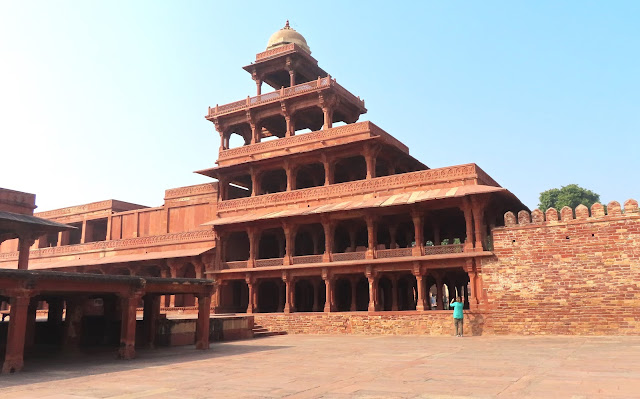 |
| Hawa Mahal - the Palace of Winds |
 |
| Another view of Hawa Mahal |
 |
The Turkish Sultana's House
Next to the pool was a huge stone Parcheesi board
where the ladies of the court would act as the game pieces. |
 |
The gardens of the palace
|
 |
| Ruins of some of the previous buildings in the garden. |
 |
The Palace of Jodha Bai, a wife of Akbar.
The architecture is a blend of styles with Hindu columns and Muslim cupolas.
|
Some of the exquisitely carved sandstone in the palaces of Fatehpur Sikri
Above the palaces, we passed through a large gate into a
great courtyard. On another wall within the courtyard stands the huge Buland
Darwaze (the Lofty Gate). This triumphal gate was built in 1575 to commemorate
Akbar’s victory over the state of Gujarat. The building is considered the
greatest monumental structure of Akbar’s reign.
 |
| The entry into the courtyard of the fortress |
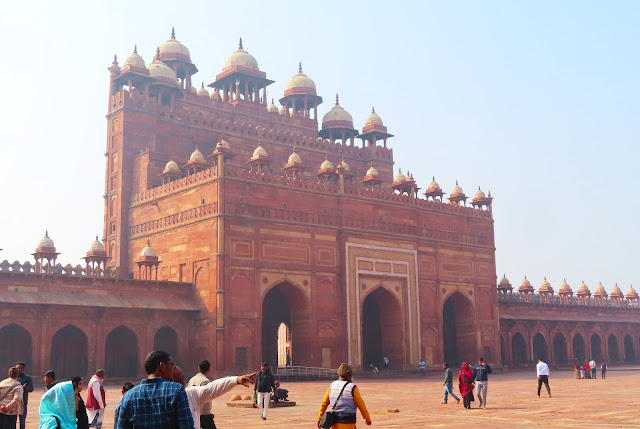 |
| Buland Darwaze - the Lofty Gate |
Also within the courtyard is the Jama Masjid,a huge mosque
that is still in use, and the white marble mausoleum of the Sufi saint, Chisti.
The tomb stands out as the only building not of red sandstone, and Chisti’s sarcophagus
inside the tomb is covered in iridescent mother-of-pearl.
 |
| Jama Masjid |
 |
| Mausoleum of Salim Chisti |
 |
| These carved "lace" windows allowed women to look out without being seen. |
 |
| The mother-of-pearl encrusted tomb of the Sufi saint. |
 |
| Some of the other sights of Fatehpur Sikri included donkeys being herded through the streets... |
 |
...and these Alexandrine parakeets.
(I don't think the barbed wire worked at keeping them off of the stonework!) |
The only downside to this visit were the dozens of
"hawkers," both men and young boys, selling their scarves, jewelry,
tiny carved chess sets, etc. who followed us persistently throughout much of
the visit. Despite our constant "No, thank you," there were a few who
followed us for a good ten minutes or more, bringing the price down a bit at a
time. PG said that we were "too nice," and that they have an instinct
for the polite people, and he finally shooed them away. I felt a bit bad always
saying no, especially to the children, but it was impossible to buy something
from everybody!
PG left us after the tour to return to Agra, and the rest of the day was
spent in the car with our driver, Pawan, who will be with us for the next
several days. The long drive was punctuated by the sights of cows in the roads, elephants (!), and small villages, including one where a wedding was taking place.
 |
| All of our drivers on this trip had small statues of a Hindu god on the dash. |
 |
| Now this is not a sight one expects to see when driving down a highway! |
 |
| The bridal procession of the groom and his male friends. |
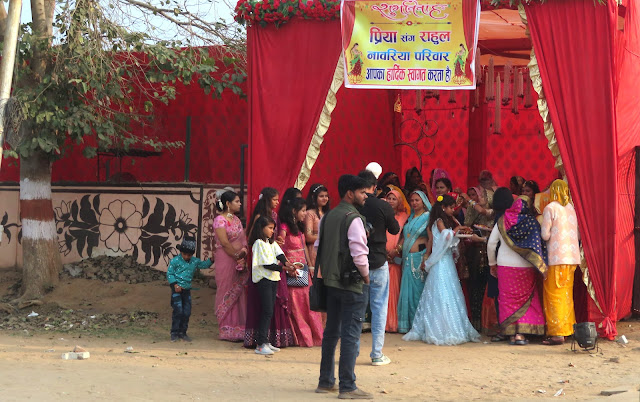 |
| The bride and her female friends were waiting at this tent. |
It was just before dark when we finally arrived at our next
lodging, another Oberoi, the Vanyavilas. Talk about a greeting! As we entered the door of the entry gate,
hundreds of rose petals rained down on us from staff members on balconies above
the door!
 |
| The entrance to the Oberoi Vanyavilas |
 |
| Rose petals are showered onto the entering guests |
In keeping with a safari visit in Ranthambore, we were
housed in a gorgeous huge "tent," which was more luxurious that most
hotel rooms we have ever stayed in. We enjoyed a wonderful dinner and went to
bed very early in preparation for our 6 a.m. safari the next day.
 |
| Our "tent" lodging at the Oberoi Vanyavilas |
 |
| Our room and backyard |
Tuesday – Hunting for Tigers (and Birds)
in the Ranthambore Tiger Reserve
The Oberoi Vanyavilas sits just outside of the Ranthambore
National Park and Tiger Reserve. (Close enough that we were warned about
walking about the grounds of the hotel after dark, as animals are occasional
visitors, in spite of the high walls.)
Ranthambore was once the private tiger
reserve of the Maharaja of Jaipur, until, in 1972, the park became one of nine reserves that became “Project Tiger,” a
national project to preserve the tigers and other wildlife of India. The dry tropical deciduous forest here
includes a wide diversity of animal life including leopards, caracals, hyenas,
jackals, jungle cats, marsh crocodiles, wild boar, sloth bears, and several
types of antelopes and deer, as well as several hundred species of birds. But the star attraction is the Royal Bengal
Tiger. There are only about 85 tigers
living in this vast hilly park, and we had high hopes of spotting one of them.
 |
| A map of the Ranthambore Tiger Reserve and Safari Zones |
Rob and I were up before dawn, met our driver and nature guide,
and set off in the still dark morning for the short drive to the gates of the
national park. The park restricts the
number of safari vehicles each day and assigns each to one of the ten “zones”
that explore different regions of the park.
Our morning drive was in Zone 4, a large area of hills and valleys, dotted
by several large lakes.
 |
| Early morning drive to the Tiger Reserve |
 |
| Our morning safari drive was in Zone 4 |
The safari here was similar in one way to our safaris in
Africa – it was not a smooth ride! Our
heads jiggled like bobble-head dolls as the vehicle bounced over the rocky
roads. But it was different in other
ways. In Africa, there were animals in
view almost all of the time in that open savannah landscape. Here, there were hills and lots of trees, so
we had to keep a vigilant look out for the infrequent animal sightings.
We drove for quite a while, enjoying the glow of the
sunrise over the distant hills when we finally spotted our first animals, a
small herd of Chital (spotted deer). At
first, I thought they were all fawns, but the Chital retains its spots throughout
its life.
 |
| The sun just peeking above the hills of Ranthambore |
 |
| A peacock prowls through the dusty landscape |
 |
| Small family of Chital, the spotted deer |
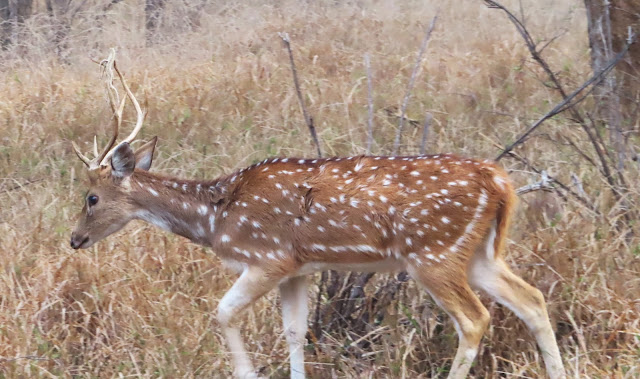 |
| Chital buck |
Soon after the chital herd, we encoutered the much larger
Sambar deer, the largest deer species in India. Throughout the morning, we saw
several groups of Chital and Sambar deers. We also passed by one Nilgai, the
largest Asian antelope, whose name literally means “Blue Cow.”
 |
| Sambar buck |
 |
| Sambar deer |
 |
Nilgai, the largest Asian antelope is known as the Blue Cow
due to the bluish tinge of its pelt. |
Rob and I and our driver and guide scanned the hills
constantly for the sight of a tiger. We
did see fresh tiger paw tracks in the dust, and at one point, our driver
suddenly accelerated the car and we went careening down the hillside at top
speed, but alas, no tiger appeared.
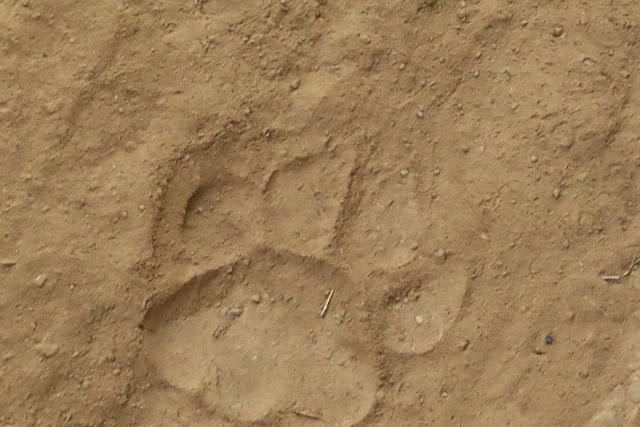 |
| We knew a tiger had been here earlier today! |
There were quite a few other animal sightings during the
morning. If you have followed my
previous nature adventures, you know I love birds, and Ranthambore holds lots
of them, both permanent and migratory species. We saw most of them along the
shores of the lakes, but I was especially excited to spot a small brown owl in
one tree and a colorful woodpecker in another.
And gorgeous peacocks, the national bird of India, live wild in this
forest and roamed everywhere.
 |
| Painted Stork |
 |
White-throated Kingfisher
|
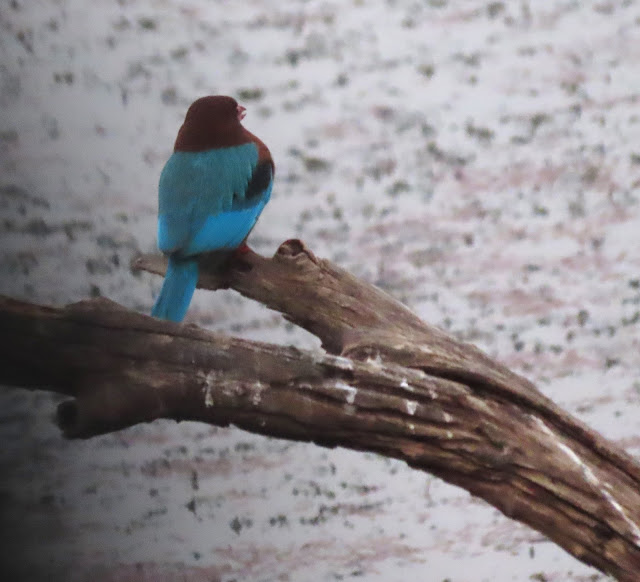 |
| White-throated Kingfisher from the back |
 |
Red-wattled Lapwing
|
 |
| Eurasian Spoonbill |
 |
Black-crowned night heron
|
 |
| Oriental Darter |
 |
Rufous Treepie
|
 |
Flock of the Rufous Treepies.
These birds were bold and fearless. They hang out at this reststop along the route and
swoop down to the vehicles to search for crumbs. One poor woman got dive-bombed
by several of the birds as she took out her purse! |
 |
| Grey Heron |
 |
| A brave Snowy Egret hanging out with a marsh crocodile |
 |
| Little Cormorant - and crocodiles on the shore |
 |
We were driving, so I missed a getting a good shot of this
Black-rumped Flameback Woodpecker.
I borrowed the photo below from Wiki Commons. |
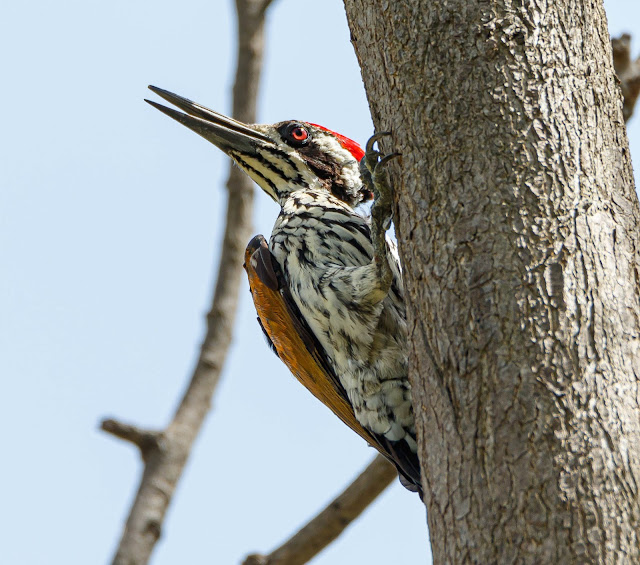 |
Black-rumped Flameback Woodpecker
|
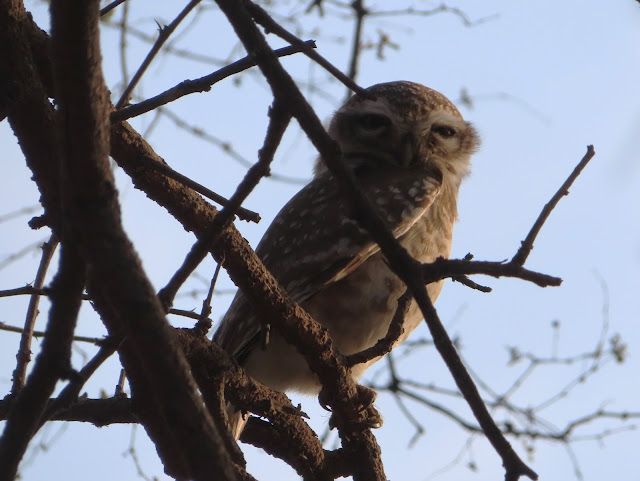 |
| Spotted Owlet |
 |
| Black-headed Ibis, aka Oriental White Ibis |
 |
| Eurasian Moorhen |
 |
| After a great deal of research, I still haven't identified the ducks above or below. |
 |
| Great White Egret in flight |
There were also lots of marsh crocodiles on the lake shores and
in the water. (So many, in fact, that I think I would not pick India as a good
place for a lakeside home!)
 |
| Another brave bird next to the lounging crocodile |
 |
| Crocs take advantage of a small island in the middle of the lake |
 |
| This tiny crocodile was near the shore in the lake vegetation. |
Other animal sightings of the morning included lots of the
Langur monkeys with their cute black faces and pointy noses, all busily jumping
through the trees or sitting on rocks grooming each other. Several scrawny babies with the faces of
little old men clung to their mothers.
We also spotted some of the wild boar, but the foliage prevented me from
getting a good photo.
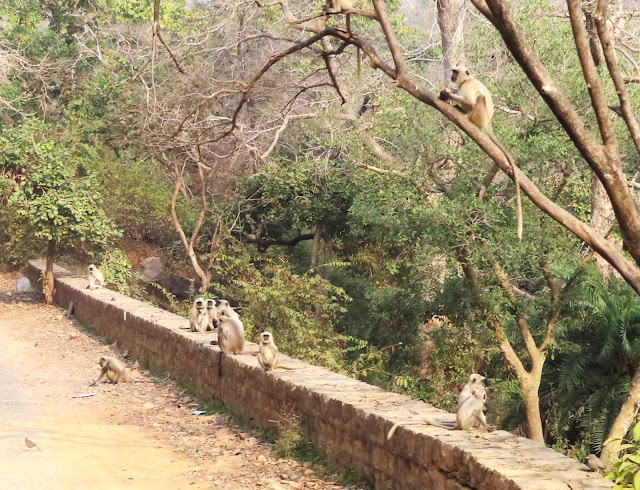 |
| Langur monkeys wait for handouts from the passing tourists |
 |
| Mother and baby Langur monkey with a red carrot |
After about three hours of trying, we finally had to admit
defeat and head back to the hotel for lunch, where we were greeted by Lakshmi,
the elephant!
 |
| Leaving the park through the old entry gate of the Maharajah's fort. |
 |
| A typical sight in India - cows and motorcycles |
 |
| Lakshmi, the elephant, greets us upon our return to the Oberoi. |
After lunch, we explored the beautiful gardens of our hotel and walked to the top of the lookout tower on the grounds for a birds-eye view of the forest.
 |
| The beautiful grounds of the Oberoi Vanyavilas |
 |
| The Tower and views of the Oberoi and the National Park beyond |
We had a second safari scheduled for the afternoon. I said
a little prayer to Ganesha, the elephant-headed god who provides good luck, and
at 2:30, we met our new nature guide and headed back into the park. The langur monkeys were there to greet us.
 |
| Our afternoon nature guide and driver |
 |
| A family of langur monkeys |
 |
| The entrance to Zone 3 |
This time, we were
in Zone 3, which turned out to be a smaller and more interesting section of the
forest, as it was once part of the grounds of the large Ranthambore Fort which
sits on the mountain above, so there were the remains of various temples and
other buildings hiding in the thick forest.
 |
| Ruins in the jungle left from the days of the Maharajahs. |
As with the morning drive, there were beautiful birds, monkeys,
crocodiles, deer, another Nilgai, and we did see a couple of mongooses, but no
tiger for a couple of hours.
 |
| Common Grey Mongoose |
 |
| Young Marsh Crocodile |
 |
| Chital (Spotted Deer) |
 |
| Chital buck with the velvet still on his antlers |
 |
| Female Sambar deer grazing in the lake |
 |
| Sambar buck |
 |
| Nilgai, the "Blue Cow" |
And more birds!
 |
| Red-wattled lapwings |
 |
| Grey Herons nesting in the tree |
 |
| Peafowl were found all over the Tiger Reserve |
 |
| Small Egret |
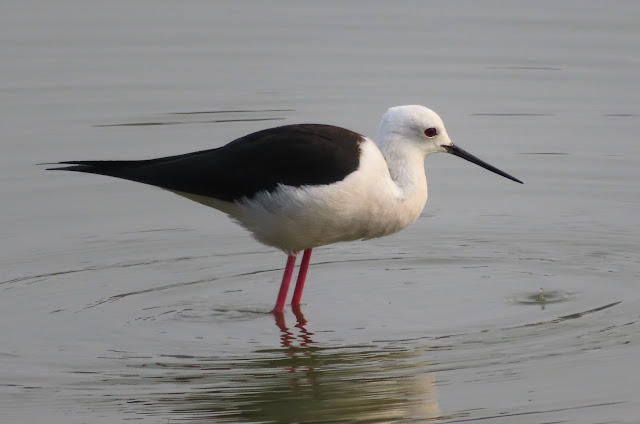 |
| Black-winged Stilt |
 |
| Oriental Darter |
 |
And my favorite bird sighting of the day -
the Great Thick-Knee (aka Great Stone-Curlew) |
Tiger!
Suddenly our guide noticed a group of vehicles on the far side
of a large lake with all the visitors training their binoculars on something
near the shore of our side of the lake below our line of vision. He was sure
this indicated a tiger sighting, so we sat for a full 45 minutes waiting for
her to appear. I was just about to give up and suggest that we move on, when
suddenly, far off, we could see something orange walking slowly through the
trees.
 |
| First view of Riddhi, the tiger |
The guides know this forest intimately, so our guide knew
exactly where she would emerge. We drove around the hill to the end of a ravine
that created a path through the forest. Riddhi came walking directly toward us.
She seemed unconcerned by our presence and walked within feet of our vehicle. Our guide knew her immediately and said she is
the great-granddaughter of Machali, a popular tiger who was featured in a
documentary, "The World's Most Famous Tiger."
We followed her along the road for several minutes, cameras
snapping away. When she turned into the bushes, we drove further down the road
to where she would appear again. We spent about twenty more minutes in Riddhi's
company, following her trail slowly as the sun got low in the sky. She finally lied down for a rest, so we said good-bye
and returned to the Oberoi Vanyavilas just in time for dinner and packing our
bags again for our next destination, the Pink City of Jaipur.
What a wonderful day!!! It is always a thrill to see animals in their
native landscape, but this time was especially breath-taking. There had been no
guarantee that we would spot a tiger, so we felt very lucky.







































































































1 comment:
What an amazing adventure!
Post a Comment